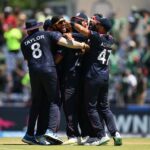The Pay Gap in Cricket: A Closer Look
by Arya

Cricket, a globally cherished sport, grapples with a pressing concern – the stark contrast in pay between male and female cricketers. Despite the surging popularity of women’s cricket and the commendable strides in professionalism among female players, a notable earnings gap persists. This blog endeavors to dissect the underlying causes of this pay divide and propose viable solutions to bridge this chasm.
Peering into the Chasm: A Comprehensive Overview
Table of Contents
ToggleThe discrepancy in pay within cricket manifests prominently across various cricket-playing nations. For instance, in cricket-crazy India, the top-tier contract for female cricketers commands a retainer of Rs 50 lakh, whereas the lowest grade for male cricketers is valued at Rs 1 crore.

Similarly, in England, statistics reveal an alarming average hourly pay gap of 38%, meaning women earn £62 for every £100 earned by men.
Underlying Factors Fueling the Divide
A multitude of factors underpin the prevailing pay gap in cricket:
- Revenue Disparity: A primary driver of this gap lies in the differential revenue generated by men’s and women’s cricket. Men’s cricket, buoyed by a larger fan base and heightened viewership, magnetizes more sponsors and consequently yields greater revenue.
- Popularity and Fan Base: Historically, men’s cricket has basked in greater popularity and amassed a larger fan base, translating into augmented ticket sales, television viewership, and sponsorship opportunities.
- Match Frequency: Male cricketers partake in a higher frequency of matches, earning substantial sums ranging from Rs 1 crore to Rs 7 crore based on their grade.
- Legacy Bias and Discrimination: Women’s cricket, regrettably, has been relegated to a secondary position historically, thereby curtailing exposure, opportunities, and remuneration for female cricketers.
Bridging the League Pay Disparity: IPL vs WPL
The Indian Premier League (IPL) and the Women’s Premier League (WPL) stand as pillars of cricketing entertainment in India, yet a notable chasm exists in the earnings of players within these leagues.
Disparity in Earnings
In the IPL arena, each franchise commands a hefty purse of INR 100 crore, enabling the acquisition of up to 25 players. Conversely, the financial prowess of WPL franchises is comparatively modest, with a purse of INR 12 crore allocated for player procurement in the 2024 auction.

Notably, the contrast in player acquisition costs further underscores this divide, with IPL’s most expensive acquisition, Mitchell Starc, fetching INR 24.75 crore in 2023, while WPL’s counterpart, Kashvee Gautam, secured a bid of INR 2 crore. Additionally, the disparity extends to prize money, with the IPL winner bagging INR 20 crore compared to WPL’s INR 6 crore.
Impact of WPL on Women Cricketers
The Women’s Premier League has emerged as a transformative force in the realm of women’s cricket in India. Serving as a springboard for domestic talent, it furnishes a platform for skill honing and spotlighting emerging stars. Through extensive media coverage, the WPL effectively engages millions of cricket enthusiasts, augmenting the visibility and allure of women’s cricket.

Furthermore, the league’s influence transcends the playing field, catalyzing several state cricket associations under the BCCI to initiate their own leagues, thus fortifying grassroots cricket development and bolstering opportunities for female cricketers. Importantly, the WPL ensures adequate financial backing for the toil, talent, and commitment exhibited by women cricketers in India.
Navigating Brand Endorsements Amidst Bollywood Glare
Women cricketers contend with formidable competition from Bollywood luminaries in the domain of brand endorsements, owing to the latter’s expansive reach, social media clout, and celebrity status.

The prevailing preference for Bollywood actresses in endorsement deals stems from their broader fan base and heightened visibility. However, with the burgeoning popularity of women’s cricket, catalyzed by the success of the WPL, this paradigm is gradually undergoing a shift.
BCCI’s Stride Towards Pay Equity
In a watershed moment, the Board of Control for Cricket in India (BCCI) unveiled plans to enforce a new pay equity policy for its contracted women cricketers in 2022, ensuring parity in match fees between male and female counterparts.

This pioneering initiative not only heralds a monumental leap forward for women’s cricket but also signifies a pivotal stride towards fostering inclusivity and gender parity within the sport.
Paving the Path to Parity: Plausible Remedies
Efforts to redress the cricket pay gap necessitate a multifaceted approach:
- Equitable Remuneration for Equal Contribution: Cricket governing bodies worldwide can champion the cause of pay equity by ensuring parity in the remuneration of male and female cricketers. Encouragingly, the Board of Control for Cricket in India (BCCI) has committed to implementing a new pay equity policy, aligning match fees for both genders.
- Amplifying Visibility and Appeal: Elevating the profile and appeal of women’s cricket can be achieved through strategic broadcast deals and robust marketing initiatives.
- Expanding Women’s Cricket Calendar: Augmenting the number of matches for female cricketers is pivotal in augmenting revenue streams and furnishing them with enhanced earning prospects.
- Revamping Contract Structures: Contracts should be revamped to incorporate fixed and flexible components sans gender bias, fostering an environment of fairness and equity.
Conclusion
The cricket pay gap represents a multifaceted quandary warranting concerted endeavors from all stakeholders, encompassing cricket boards, players, enthusiasts, and sponsors. While strides have been made in the pursuit of parity, there remains a considerable distance to traverse. Sustained dialogue and collaborative action are imperative in charting a course toward a more just and inclusive cricketing landscape.
In essence, while a pronounced pay gap persists between IPL and WPL, concerted efforts are underway to narrow this chasm. The WPL’s catalytic impact on women’s cricket in India, coupled with initiatives such as the BCCI’s equal pay policy, heralds a promising trajectory towards a more equitable and inclusive future for cricket.

We hope this blog has shed some light on the pay gap in cricket and the steps being taken to bridge it. The journey towards equality is a long one, but with continued dialogue and action, we can hope to see a more equitable future in cricket.
We would love to hear your thoughts on this issue. Please feel free to leave your comments below. Your feedback and insights can help enrich this discussion.
For more such news, updates, and exclusive content, don’t forget to follow us on Instagram and Twitter. Also, make sure to subscribe to our blog to stay updated on the latest happenings in the world of cricket.
Thank you for reading, and stay tuned for more insightful discussions!
Related
Cricket, a globally cherished sport, grapples with a pressing concern – the stark contrast in pay between male and female cricketers. Despite the surging popularity of women’s cricket and the commendable strides in professionalism among female players, a notable earnings gap persists. This blog endeavors to dissect the underlying causes of this pay divide and…



